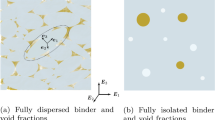Abstract
The dynamic mechanical behavior of PBX1314 is examined by means of a micromechanical model. The basis for this work is Eshelby theory. The effective moduli derived by Weng and Tandon are used for the randomly oriented two-phase composites. The dynamic mechanical behavior of the PBX1314 is described as a function of aspect ratio and inclusion concentration. The viscoelastic behavior of the polymer binder is modeled using a generalized Maxwell model with a Prony series representation for the stress relaxation functions. Numerical inverse Laplace transform required by the model can be performed analytically. To demonstrate the utility and validity of the theory, we compare its predictions to several dynamic compressive experiments on the PBX1314. We also compare the predictions of the present model to the theoretical results derived by Mas and Clements. Their studies can be used to assess the properties of energetic composites, and this method is a useful tool for the design of energetic composites.
Similar content being viewed by others
References
Meyer, R., Köhler, J., Homburg, A.: Explosives. Explosives (2007)
Asay, B.W.: Shock Wave Science and Technology Reference Library. Non-shock Initiation of Explosives, vol. 5. Springer, Berlin (2010)
Banerjee, B., Cady, C.M., Adams, D.O.: Micromechanics simulations of glass-estane mock polymer bonded explosives. Model. Simul. Mater. Sci. Eng. 11, 457–475 (2003)
Banerjee, B., Adams, D.O.: Micromechanics-based determination of effective elastic properties of polymer bonded explosives. Phys. B 338, 8–15 (2003)
Banerjee, B., Adams, D.O.: On predicting the effective elastic properties of polymer bonded explosives using the recursive cell method. Int. J. Solids Struct. 41, 481–509 (2004)
Bardenhagen, S.G., Brackbill, J.U.: Dynamic stress bridging in granular material. J. Appl. Phys. 83, 5732–5740 (1998)
Bardenhagen, S.G., Brackbill, J.U., Sulsky, D.: The material-point method for granular materials. Comput. Methods Appl. Mech. Eng. 187, 529–541 (2000)
Brinson, L., Lin, W.: Comparison of micromechanics methods for effective properties of multiphase viscoelastic composites. Compos. Struct. 41, 353–367 (1998)
Lévesque, M., Derrien, K., Mishnaevski Jr., L., Baptiste, D., Gilchrist, M.D.: A micromechanical model for nonlinear viscoelastic particle reinforced polymeric composite materials-undamaged state. Compos. A: Appl. Sci. Manuf. 35, 905–913 (2004)
Clements, B.E., Mas, E.M.: Dynamic mechanical behavior of filled polymers. I. Theoretical developments. J. Appl. Phys. 90, 5522–5534 (2001)
Mas, E.M., Clements, B.E.: Dynamic mechanical behavior of filled polymers. II. Applications. J. Appl. Phys. 90, 5535–5541 (2001)
Clements, B.E., Mas, E.M.: A theory for plastic-bonded materials with a bimodal size distribution of filler particles. Model. Simul. Mater. Sci. Eng. 12, 407–421 (2004)
Li, J., Weng, G.: Effective creep behavior and complex moduli of fiber-and ribbon-reinforced polymer–matrix composites. Compos. Sci. Technol. 52, 615–629 (1994)
Weng, G.: Some elastic properties of reinforced solids, with special reference to isotropic ones containing spherical inclusions. Int. J. Eng. Sci. 22, 845–856 (1984)
Wang, Y., Weng, G.: The influence of inclusion shape on the overall viscoelastic behavior of composites. J. Appl. Mech. 59, 510–518 (1992)
Li, J., Weng, G.: Strain-rate sensitivity, relaxation behavior, and complex moduli of a class of isotropic viscoelastic composites. J. Eng. Mater. Technol. 116, 495–504 (1994)
Li, J., Weng, G.: Stress–strain relations of a viscoelastic composite reinforced with elliptic cylinders. J. Thermoplast. Compos. Mater. 10, 19–30 (1997)
Eshelby, J.D.: The determination of the elastic field of an ellipsoidal inclusion, and related problems. Proc. R. Soc. Lond. Math. Phys. Eng. Sci. 241, 376–396 (1957)
Eshelby, J.D.: The elastic field outside an ellipsoidal inclusion. Proc. R. Soc. Math. Phys. Eng. Sci. 252, 561–569 (1959)
Tandon, G., Weng, G.: Average stress in the matrix and effective moduli of randomly oriented composites. Compos. Sci. Technol. 27, 111–132 (1986)
Idar, D., Thompson, D., Gray, G., Blumenthal, W., Cady, C., Peterson, P., Roemer, E., Wright, W., Jacquez, B.: Influence of polymer molecular weight, temperature, and strain rate on the mechanical properties of PBX 9501 (2002)
Blumenthal, W., Gray, G., 3rd, Idar, D., Holmes, M., Scott, P., Cady, C., Cannon, D.: Influence of temperature and strain rate on the mechanical behavior of PBX 9502 and Kel-F \(800^{{\rm TM}}\). Shock Compress. Condens. Matter 1999, 671–674 (2000)
Colak, O.U.: Mechanical behavior of PBXW-128 and PBXN-110 under uniaxial and multiaxial compression at different strain rates and temperatures. Turk. J. Eng. Environ. Sci. 32, 390–395 (2004)
Xiao, Y.C., Sun, Y., Li, X., Zhang, Q.H., Liu, S.W., Yang, H.: Dynamic mechanical behavior of PBX. Propellants Explos. Pyrotech. 41, 629–636 (2016)
Tobolsky, A.V., Catsiff, E.: Elastoviscous properties of polyisobutylene (and other amorphous polymers) from stress–relaxation studies. J. Polym. Sci. 19, 111–121 (1956)
Williams, M.L., Landel, R.F., Ferry, J.D.: The temperature dependence of relaxation mechanisms in amorphous polymers and other glass-forming liquids. J. Am. Chem. Soc. 77, 3701–3707 (1955)
Mas, E.M., Clements, B.E., Blumenthal, W.R., Cady, C.M., Gray, G.T., Liu, C.: A viscoelastic model for PBX binders. In: Furnish, M.D., Thadhani, N.N., Horie Y. (Eds.) Shock Compression of Condensed Matter, pp. 661–664 . Office of Scientific & Technical Information Technical Reports (2001)
Xue, L., Borodin, O., Smith, G.D., Nairn, J.: Micromechanics simulations of the viscoelastic properties of highly filled composites by the material point method (MPM). Model. Simul. Mater. Sci. Eng. 14, 703 (2006)
Cost, T.L., Becker, E.B.: A multidata method of approximate Laplace transform inversion. Int. J. Numer. Methods Eng. 2, 207–219 (1970)
Kwok, Y.-K., Barthez, D.: An algorithm for the numerical inversion of Laplace transforms. Inverse Prob. 5, 1089 (1989)
De Hoog, F.R., Knight, J., Stokes, A.: An improved method for numerical inversion of Laplace transforms. SIAM J. Sci. Stat. Comput. 3, 357–366 (1982)
Author information
Authors and Affiliations
Corresponding author
Rights and permissions
About this article
Cite this article
Xiao, Y., Sun, Y., Yang, Z. et al. Study of the dynamic mechanical behavior of PBX by Eshelby theory. Acta Mech 228, 1993–2003 (2017). https://doi.org/10.1007/s00707-017-1809-4
Received:
Revised:
Published:
Issue Date:
DOI: https://doi.org/10.1007/s00707-017-1809-4




